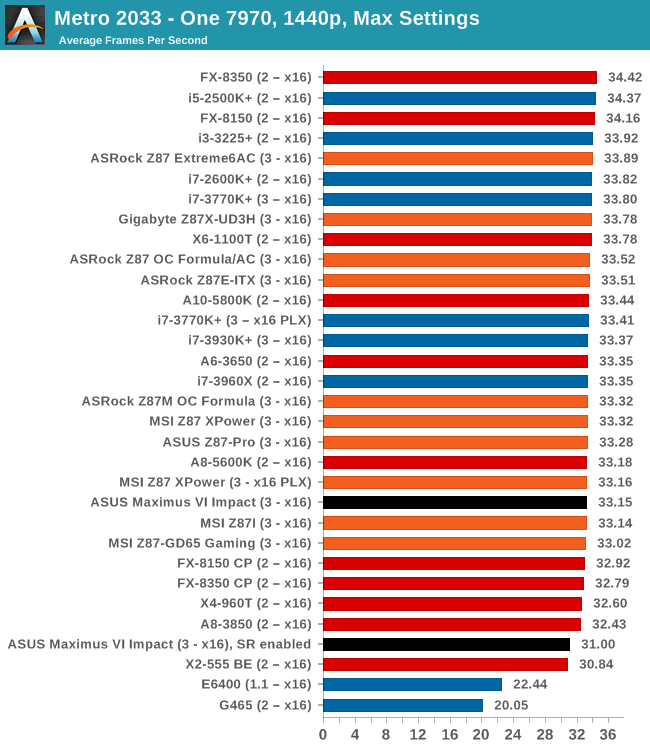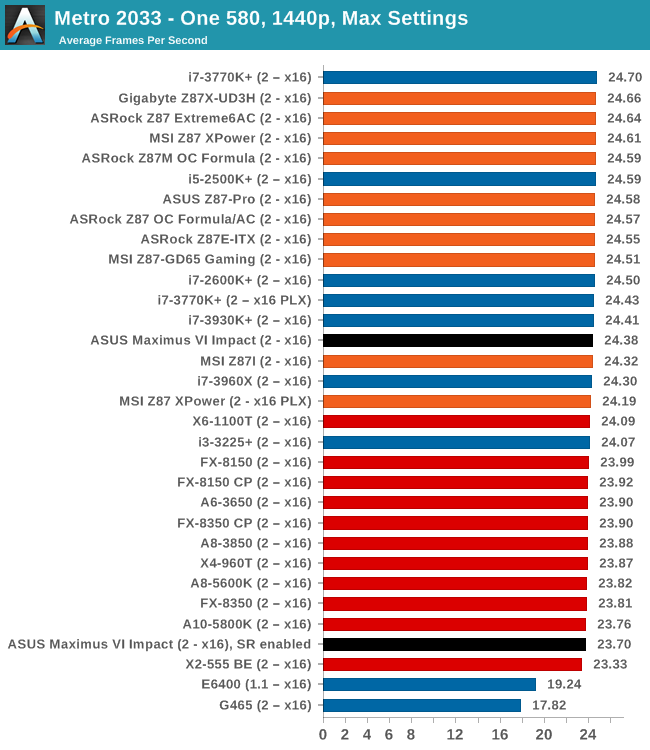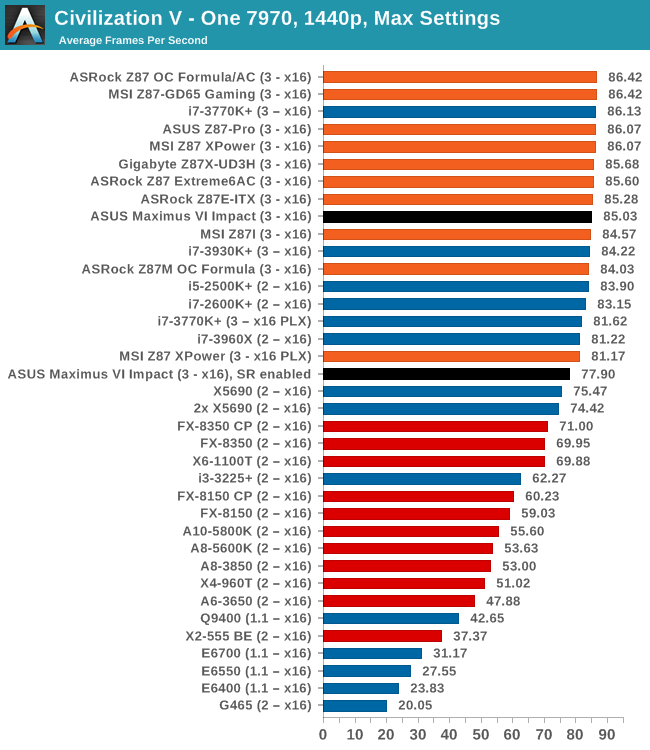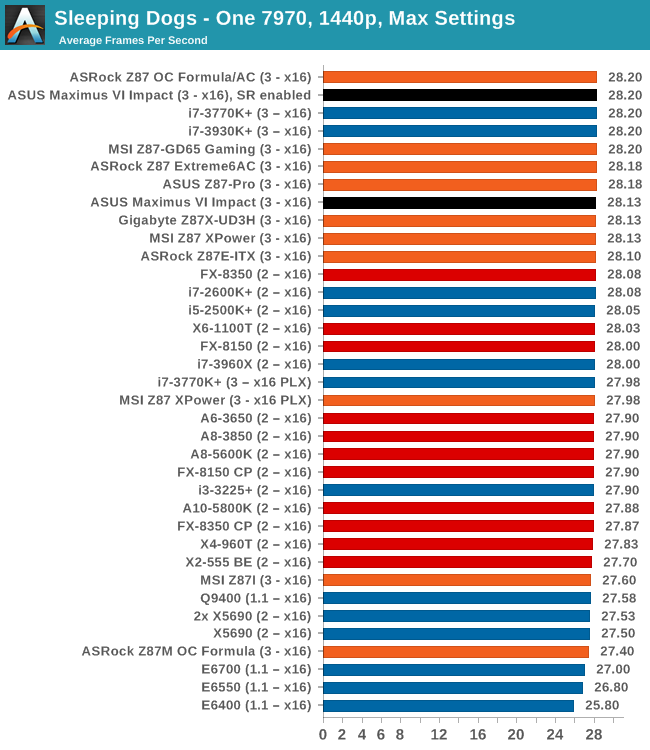ASUS Maximus VI Impact Review: ROG and Mini-ITX
by Ian Cutress on November 22, 2013 10:00 AM ESTGaming Benchmarks
While writing this review and inputting the benchmark numbers into my custom database, I came across a significant discrepancy in the gaming benchmark performance of the Impact against other motherboards in three out of four of our gaming tests. In our testing configurations, we saw a 2 FPS dip against other Z87 motherboards. The culprit it seems is Sonic Radar, the new software designed to aid gamers with a visual representation of directional audio. To put this into perspective, this is what I saw in my testing with Metro 2033:
Settings: 1440p, max everything. CPU at stock, XMP enabled, benchmark mode.
With Sonic Radar enabled, 31.00 FPS and the following frame rate graph:
Without Sonic Radar enabled, 33.15 FPS and the following frame rate graph:
Now it is painfully obvious that the FPS graph with Sonic Radar is manic. Regular fluctuations up to 300 FPS are noticeable at this level of gameplay, whereas it was not noticeable in Dirt 3. This is the first generation of Sonic Radar release, and I am conversing with ASUS whether there is something fundamental with Sonic Radar, or my system setup, that is causing this affect. I have put both SR and non-SR numbers in the benchmark results below.
Metro2033
Our first analysis is with the perennial reviewers’ favorite, Metro2033. It occurs in a lot of reviews for a couple of reasons – it has a very easy to use benchmark GUI that anyone can use, and it is often very GPU limited, at least in single GPU mode. Metro2033 is a strenuous DX11 benchmark that can challenge most systems that try to run it at any high-end settings. Developed by 4A Games and released in March 2010, we use the inbuilt DirectX 11 Frontline benchmark to test the hardware at 1440p with full graphical settings. Results are given as the average frame rate from a second batch of 4 runs, as Metro has a tendency to inflate the scores for the first batch by up to 5%.


Dirt 3
Dirt 3 is a rallying video game and the third in the Dirt series of the Colin McRae Rally series, developed and published by Codemasters. Dirt 3 also falls under the list of ‘games with a handy benchmark mode’. In previous testing, Dirt 3 has always seemed to love cores, memory, GPUs, PCIe lane bandwidth, everything. The small issue with Dirt 3 is that depending on the benchmark mode tested, the benchmark launcher is not indicative of game play per se, citing numbers higher than actually observed. Despite this, the benchmark mode also includes an element of uncertainty, by actually driving a race, rather than a predetermined sequence of events such as Metro 2033. This in essence should make the benchmark more variable, but we take repeated in order to smooth this out. Using the benchmark mode, Dirt 3 is run at 1440p with Ultra graphical settings. Results are reported as the average frame rate across four runs.


Civilization V
A game that has plagued my testing over the past twelve months is Civilization V. Being on the older 12.3 Catalyst drivers were somewhat of a nightmare, giving no scaling, and as a result I dropped it from my test suite after only a couple of reviews. With the later drivers used for this review, the situation has improved but only slightly, as you will see below. Civilization V seems to run into a scaling bottleneck very early on, and any additional GPU allocation only causes worse performance.
Our Civilization V testing uses Ryan’s GPU benchmark test all wrapped up in a neat batch file. We test at 1080p, and report the average frame rate of a 5 minute test.


Sleeping Dogs
While not necessarily a game on everybody’s lips, Sleeping Dogs is a strenuous game with a pretty hardcore benchmark that scales well with additional GPU power due to its SSAA implementation. The team over at Adrenaline.com.br is supreme for making an easy to use benchmark GUI, allowing a numpty like me to charge ahead with a set of four 1440p runs with maximum graphical settings.














69 Comments
View All Comments
slayernine - Monday, November 25, 2013 - link
Part of the added value of this board was the included anti-virus. It is not a trial but a full version and helped me justify the cost of this luxurious motherboard.Oscarcharliezulu - Wednesday, November 27, 2013 - link
I love good looking hardware and I must say this board looks like its worth the money, it looks awesome and whilst it shouldn't, really makes me want to own it. What I would like to see though is an ITX board with 4 dim slots so I can run 32gb ram, and the full 6sata ports, but I have no idea where they would fit, I guess they'd have to be sodimms.Anosh - Wednesday, December 4, 2013 - link
Can someone please tell me which Wireless card is mounted on the motherboard?Is it able to run at 1300Mbps on AC?
MiniItxLinux - Wednesday, December 4, 2013 - link
When I look at this I think Thundercats...Must be the color scheme.
Hoooooo!!
martinot - Friday, December 6, 2013 - link
This really looks like a great board and a perfect buy for my needs, but I really dislike that you need Java installed on your machine to be able to configure it. Besides screwing up the DPC (which is critical as I produce and DJ music) it is also the biggest backdoor and security risk you can have.It is almost beyond stupidity and carelessness for security and their customers that Asus forces you to install such software package with such a bad track record as Java. When almost all vendors and websites has stopped using it (for very good reasons) - Asus does the oposite and starts using it. Wierd.
I was almost sure this was the perfect fully featured board for my mini-ITX build until I read that it needs Java installed. Too bad I have to search for another board, and I am not sure I will find anyone this such good hardware as this one (looks really awesome otherwise).
br,
martin
dcoca - Friday, January 9, 2015 - link
You don't need to install the software to utilize the board... it runs like a champ without any software from Asus and silentHarry_Wild - Monday, December 23, 2013 - link
ASUS Maximus VI Impact board might be the starting point for my DIY home theater PC!ReneGQ - Thursday, March 13, 2014 - link
I recently purchased an Asus Motherboard and the problems started from day 1. The drivers update never works, the same for AI Suite III (there´s a lot of updates for this model in Asus webpage). After 2 months I still can´t install BitDefender cause a clock watchdog error.Asus technical support is the worst, mails comes and goes with no solution.
I will not recommend this brand to anyone. The brand has a very good Marketing but the product and the service are very disappointment.
dcoca - Friday, January 9, 2015 - link
Sorry to hear that bro, I have this board for a while now and I can say it's stable, no issue what's so ever.